
|
Special Effects (F/X) - Milestones in Film 1980-1982 |
| Film Title/Year and Description of Visual-Special Effects | ||||||||||||||

|
An American Werewolf in London (1981, US/UK)
It told how backpacking American college student/tourist in the Yorkshires David Kessler (David Naughton) turned into a werewolf/lycanthrope - his body, face, and limbs crunched and his skin bubbled as it grew hair and his body stretched out and was elongated.
The transformation scenes were created entirely through a combination of prosthetics and robotics.
[Note: Some of the same special effects techniques were also used in Joe Dante's horror/comedy The Howling (1981) which featured stunning metamorphosis sequences of man-into-wolf (see below).] |
     
|
||||||||||||

|
Dragonslayer (1981) This sword-'n'-sorcery film, a co-production of Walt Disney and Paramount, introduced the innovative technique of Go-Motion, a process created by Industrial Light & Magic (and Lucas animator Phil Tippett). It was a variation on the earlier technique of "stop-motion" animation (popularized by Willis O'Brien and Ray Harryhausen), by having the animated model (the Dragon) make several moves within a frame, thereby giving it a more fluid, blurry, and natural movement. By contrast, the traditional stop-motion technique was more jerky, static and wooden in appearance, as in Harryhausen's Clash of the Titans (1981) released in the same year. |

|
||||||||||||

|
The Howling (1981) Joe Dante's horror/comedy The Howling (1981) featured stunning metamorphosis, shape-shifting sequences of man-into-wolf (one was juxtaposed with a TV scene of the Big Bad Wolf in The Three Little Pigs (1933)). The special groundbreaking makeup effects were originally to be produced by makeup wizard Rick Baker, but director Landis took him away to work on An American Werewolf in London (1981) (see above), so Baker's assistant Rob Bottin filled in - this was before the days of CGI. During a memorable werewolf transformation scene with incredible special effects, the pneumatic transformations - without CGI effects - changed in real-time, accompanied by crackling noises:
[Note: The third werewolf film of the same year was Wolfen (1981).] |
 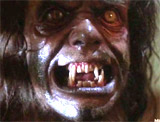  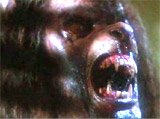 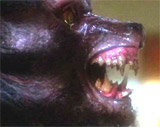
|
||||||||||||

|
Looker (1981) The visual effects in Michael Crichton's high-tech science-fiction thriller featured the first CGI human character, model Cindy (Susan Dey of The Partridge Family fame). In the story, Cindy stripped naked and allowed herself to have her body digitally scanned by the Digital Matrix research firm, to create a 3D computer-generated model of her entire figure.
Her digitization was visualized by a computer-generated simulation of her body being topographically scanned - notably the first use of shaded 3D CGI in a feature film. Polygonal models obtained by digitizing a human body were used to render the effects. |
  
|
||||||||||||
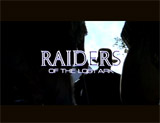
|
Raiders
of the Lost Ark (1981) A few more of the film's most remarkable special effects shots included:
|
 The Boulder 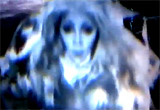 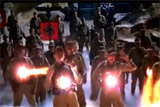 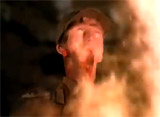 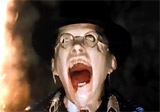 The Ark of the Covenant Sequence |
||||||||||||
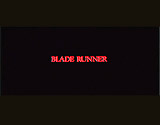
|
One of the most awe-inspiring visuals in film history, paying homage to Lang's Metropolis (1927), was the powerful vision of the Los Angeles cityscape at night, circa 2019, with giant, fire-belching towers, floating advertisements, giant television screens, and police "spinners" (flying cars). It was as if Los Angeles' sprawl was one giant oil refinery. The dark, futuristic vision of LA was accomplished using model shots and painted backgrounds. All images were based on the art design of legendary artist Syd Mead, who would collaborate with Jean 'Moebius' Giraud on TRON (1982) (see below). |
 
Los Angeles Cityscape |
||||||||||||

|
The Dark Crystal (1982) The film was composed entirely of puppets, matte paintings, and some miniature sets. The character and world designs were made by famed fantasy artist Brian Froud. |

|
||||||||||||
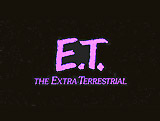
|
It was famous for the flying bicycle scene in which the kids escaped into the air on their bicycles, and later the scene of the alien and Eliott illuminated in silhouette (using miniatures) against a giant-size full moon. Also, visual effects were employed for E.T.'s spaceship, and the believable alien itself (and its glowing red heart), although altered or digitally-enhanced in the 2002 remake for the 20th anniversary edition. (See below) |
  
|
||||||||||||
 |
Koyaanisqatsi (1982) |

|
||||||||||||

|
Pink Floyd: The Wall (1982) The animation of political cartoonist Gerard Scarfe was created for both Pink Floyd's multimedia concert and for the 95 minute Alan Parker film. It was a musical "free form video" masterpiece - a remarkable descent into madness and insanity through a series of rambling music video segments by burned-out and depressed rock singer Pink (Bob Geldorf) in a Los Angeles hotel room, mostly mindlessly watching TV - he constructed a physical and metaphorical protective wall around himself after the death of his father as he experienced flashbacks of his life and attempted to tear down his wall. There were 15 minutes of memorable, adult-themed animation that appeared periodically during the film by cartoonist Gerald Scarfe (including symbolic, sexually-explicit, botanical Freudian animation). It was one of the first truly adult animated work in terms of maturity - sexually and politically. One segment presented a misogynistic woman-as-destroyer/devourer motif. In the passionate "flowers" scene before the rock song "Empty Spaces," two flowers, one shaped like a male organ and the other like a female organ -- morphed into a couple having intercourse and then engaged in a bloody fight when the female flower revealed sharp teeth and devoured the male. Two of the most indelible animated images were of a dove that imploded and morphed into a dark monstrous bird of prey -- a fighter plane bomber over London, and as Pink envisioned himself as an eyebrowless, racist, fascist Hitler-like leader of a Nuremberg-like rally in "In the Flesh," marching hammers goose-stepped across ruins.
[Note: The film also featured one of the earliest commercial uses of time-lapse photography. In "Another Brick in the Wall, Part 2," there was disturbing imagery of schoolchildren in an authoritarian oppressive school turning into conforming, faceless zombies on an assembly line and stepping off into a meat-grinder.] |
   Adult-Themed Animations  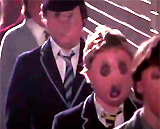  "Another Brick in the Wall, Part 2" |
||||||||||||

|
Star Trek II: The Wrath of Khan (1982) [Note: This scene would be re-used for Star Trek III: The Search for Spock (1984) and Star Trek IV: The Voyage Home (1986).] The so-called "Genesis Effect" - a one-minute animated sequence, was cinema's first entirely computer-generated (CG) sequence. It marked the first cinematic use of a fractal-generated landscape, particle effects (a particle-rendering system was used to achieve the fiery effect), and 32-bit RGBA paint software created by Lucasfilm's Pixar group division at ILM. The computerized simulation was first seen in a video proposal or demonstration presented by Dr. Carol Marcus (Bibi Besch), in which the once-dead planet was struck by a Genesis 'torpedo' and reborn or revived, as the camera raced quickly across the reddish and then greening surface of the barren planet, before becoming a reborn globe. Dr. Marcus headed up Project Genesis, a computer-simulated endeavor that sought to transform or re-animate uninhabitable worlds into lush paradises ("life from lifelessness"). She narrated the video and animation, in person and in voice-over:
The film also included the scene of Captain Spock's (Leonard Nimoy) self-sacrificial death to save the USS Enterprise from the Genesis Device explosion, with his ejection-burial in space to orbit around the newly-birthed planet caused by the Genesis Effect. Another special effect was the scene of the brain-munching earwigs, in which vengeful superhuman Khan (Ricardo Montalban) placed a parasitic, insanity-causing Ceti eel into the ears of Officer Chekov (Walter Koenig) and Captain Terrell (Paul Winfield). |
      The Genesis Effect  Brain-Munching Earwigs |
||||||||||||

|
TRON (1982) It was refused an Academy Awards nomination because the voters felt the film "cheated" by using computer animation. In reality, the process was an extremely arduous one for animators. Seven years later, James Cameron's The Abyss (1989) won the Best Visual Effects Oscar for the same kind of technology. TRON was the first live-action film to use computer-generated imagery (CGI) to any lengthy degree (about 20 minutes) - in this case, it created a full 3-D graphics world, in its most innovative sequence of the famed racing bike or Lightcycle sequence depicting computerized lightcycles in a high-speed race.
The Lightcycle sequence
used the artwork and vision of legendary artists Syd Mead and Jean
'Moebius' Giraud, and visual effects done with a combined effort by
Triple I, MAGI/Synthavision, Robert Abel
& Associates, and Digital Effects. [Note: Lisberger's animated film Animalympics (1980) had extensively used the effect in semi-preparation for what would become TRON.] The film also featured a soundtrack by Wendy (nee Walter) Carlos that melded synthesized music with the London Philharmonic's orchestral music. |
     
|
||||||||||||
 Where the Wild Things Are (2009) |
Where the Wild Things Are (1982-83) Maurice Sendak's children's book Where the Wild Things Are was the basis for Disney's experimental 35mm test footage, directed by John Lasseter (the future animator at Pixar). This revolutionary animation combined (or digitally composited) both:
Another film adaptation (with live-action and animation) of the book was released in late 2009, directed by Spike Jonze. |
 
|
||||||||||||